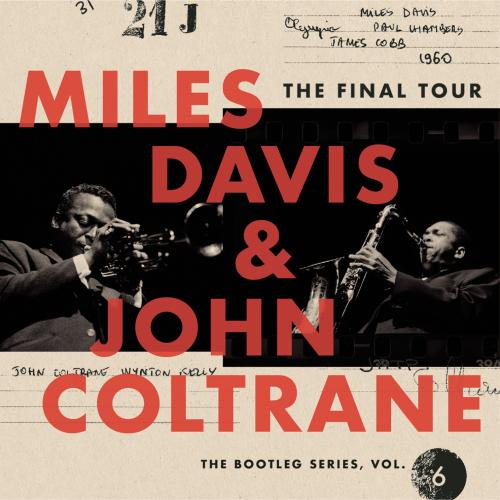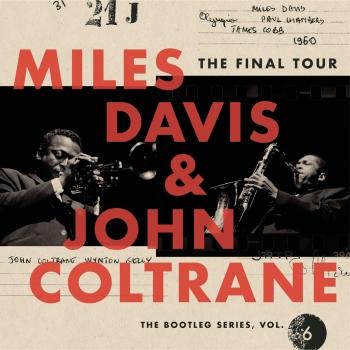
The Final Tour: The Bootleg Series, Vol. 6 (Remastered) Miles Davis & John Coltrane
Album info
Album-Release:
1960
HRA-Release:
23.03.2018
Album including Album cover
I`m sorry!
Dear HIGHRESAUDIO Visitor,
due to territorial constraints and also different releases dates in each country you currently can`t purchase this album. We are updating our release dates twice a week. So, please feel free to check from time-to-time, if the album is available for your country.
We suggest, that you bookmark the album and use our Short List function.
Thank you for your understanding and patience.
Yours sincerely, HIGHRESAUDIO
- 1 All of You (Live from Olympia Theatre, Paris) 17:05
- 2 So What (Live from Olympia Theatre, Paris) 13:25
- 3 On Green Dolphin Street (Live from Olympia Theatre, Paris) 14:40
- 4 Walkin' (Live from Olympia Theatre, Paris) 15:52
- 5 Bye Bye Blackbird (Live from Olympia Theatre, Paris) 14:01
- 6 Round Midnight (Live from Olympia Theatre, Paris) 05:37
- 7 Oleo (Live from Olympia Theatre, Paris) 04:22
- 8 The Theme (Live from Olympia Theatre, Paris) 00:50
- 9 Introduction (Live from Tivoli Konsertsal, Copenhagen) 01:00
- 10 So What (Live from Tivoli Konsertsal, Copenhagen) 14:36
- 11 On Green Dolphin Street (Live from Tivoli Konsertsal, Copenhagen) 14:35
- 12 All Blues (Live from Tivoli Konsertsal, Copenhagen) 15:31
- 13 The Theme (incomplete) (Live from Tivoli Konsertsal, Copenhagen) 00:31
- 14 Introduction by Norman Granz (Live from Konserthuset, Stockholm) 01:11
- 15 So What (Live from Konserthuset, Stockholm) 10:35
- 16 Fran Dance (Live from Konserthuset, Stockholm) 07:25
- 17 Walkin' (Live from Konserthuset, Stockholm) 16:21
- 18 The Theme (Live from Konserthuset, Stockholm) 00:53
- 19 So What (Second Concert) (Live from Konserthuset, Stockholm) 15:20
- 20 On Green Dolphin Street (Live from Konserthuset, Stockholm) 13:40
- 21 All Blues (Live from Konserthuset, Stockholm) 16:10
- 22 The Theme (Second Concert) (Live from Konserthuset, Stockholm) 00:59
- 23 John Coltrane Interview (Live from Konserthuset, Stockholm) 06:13
Info for The Final Tour: The Bootleg Series, Vol. 6 (Remastered)
The latest entry in the award-winning Miles Davis Bootleg Series focuses on the final chapter in the landmark collaboration between Davis and saxophonist John Coltrane: their last live performances together, in Europe in the spring of 1960.
Miles and Coltrane first collaborated in 1955, when Davis recruited the tenor saxophonist alongside pianist Red Garland, bassist Paul Chambers and drummer Philly Joe Jones. This "first great quintet" made their Columbia Records debut in 1957. Those early recordings showcased the stunning contrasts between Miles' spacious, melodic lines and Trane's cascading high-energy solos, famously described by the critic Ira Gilter in 1958 as "sheets of sound."
While the quintet disbanded shortly after the release of 'Round About Midnight, Coltrane was back in Miles' ensemble in early 1958. A year late, the Miles Davis Sextet (Davis, Coltrane, Chambers, saxophonist Julian "Cannonball" Adderley, pianists Bill Evans or Wynton Kelly, and drummer Jimmy Cobb) recorded the historic Kind Of Blue, the best-selling jazz album of all time. And for this final tour the rhythm section of Kelly, Chambers and Cobb backed Miles and Trane.
These historic performances marked Miles and Trane's last outing together and showcased both musicians' incredible influence on the changing sound of jazz. The beautiful music they made together is presented here officially for the very first time.
The 4x album set The Final Tour: The Bootleg Series Vol. 6 includes concerts recorded in Paris, Copenhagen and Stockholm.
Miles Davis, trumpet
John Coltrane, tenor saxphone
Wynton Kelly, piano
Paul Chambers, bass
Jimmy Cobb, drums
Digitally remastered
Miles Davis (1926-1991)
is one of the world’s most iconic, influential and acclaimed figures in the history of jazz, 20th century music and beyond. During his five-decade career as trumpeter, bandleader and composer, he was a prime mover and trendsetter in the evolution of jazz as an art form. Davis recorded a number of classic albums on Prestige Records between 1951 and 1961, including his debut as a bandleader, The New Sounds (1951), which also introduced Miles as composer of future bebop jazz standard “Dig”, a composition that has been recorded by numerous other jazz artists including Sonny Rollins, Archie Shepp and Donald Byrd. Miles’ next album Blue Period (1953) featured “Out Of The Blue” and “Bluing”, both of which were recorded during the making of The New Sounds album and reappeared on the 1956 album Dig along with the title track itself. In 1954 came the Miles Davis Quartet album, which featured “Tune Up”, “Smooch”, “Miles Ahead” and jazz standards “Four” and “Blue Haze”. The Musings Of Miles album (1955) featured yet another Davis standard “Green Haze”. What followed in 1956 for Davis was a busy year of recordings and releases including Miles Davis And Horns, which featured the composition “Down”, and Collectors’ Items, which featured the “The Serpent’s Tooth” and “Compulsion”. It was on the 1957 album Walkin’ that one of Davis’ greatest compositions, modern jazz standard “Solar” first appeared. Covered by dozens of jazz greats including Bill Evans, Dave Holland and Jack DeJohnette, the first two bars of “Solar” adorn Davis’ tombstone. Always an explorer of unknown musical paths, Davis the composer was a creature of innate intellect, primal instinct and improvisational perfection.
This album contains no booklet.











